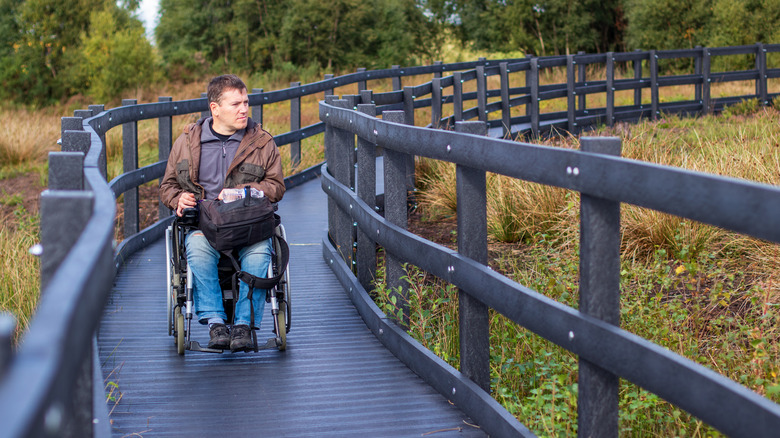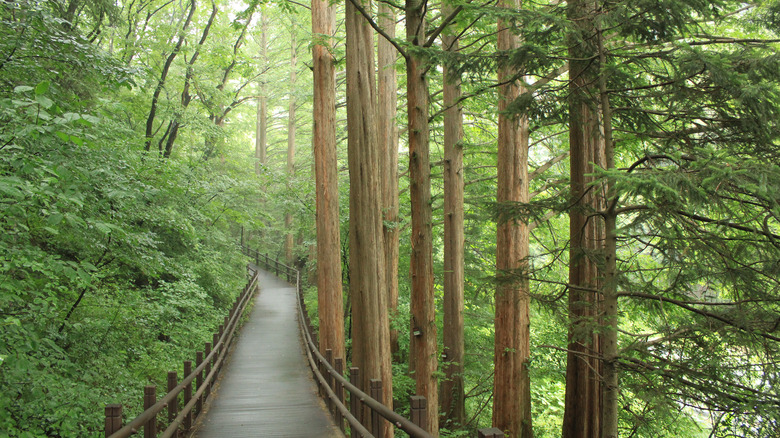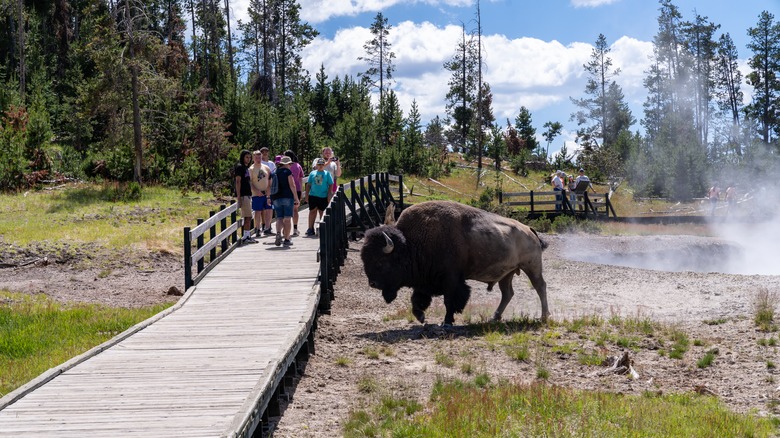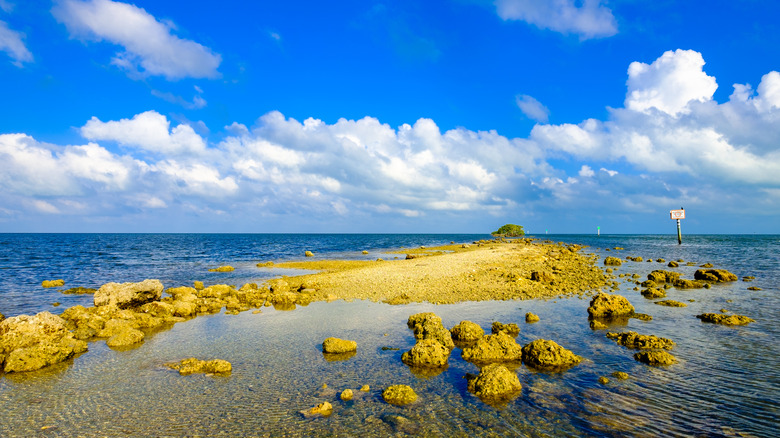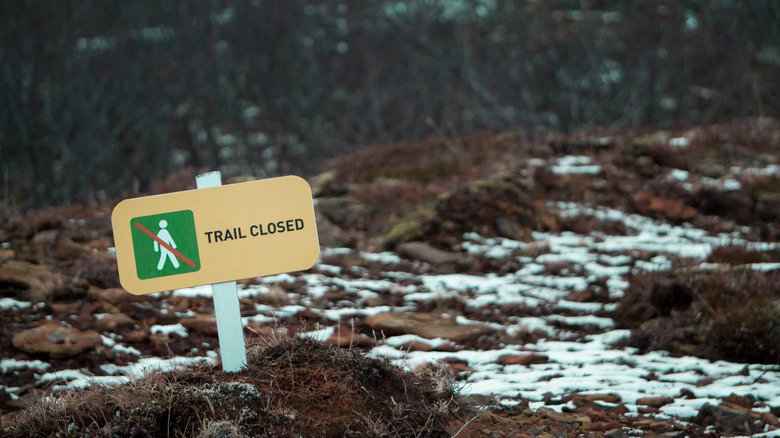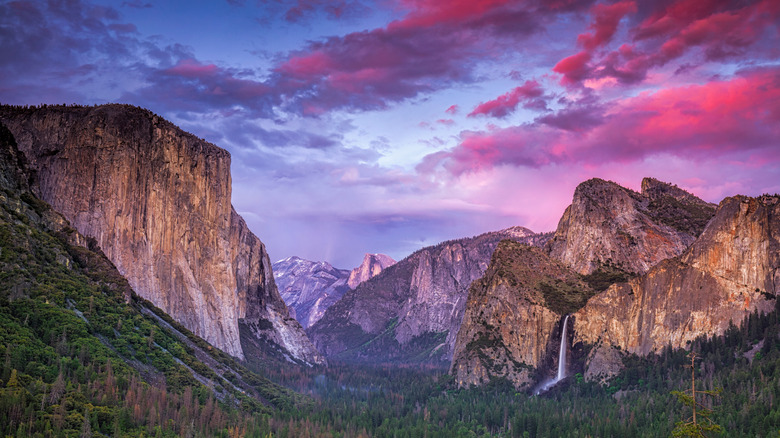Experts Reveal The Best And Worst US National Parks In Terms Of Accessibility - Exclusive
84 million acres! The National Parks System here in the United States is comprised of 423 national parks peppered across 84 million acres of mountains, valleys, historic battlefields, waterways, and more. What a tremendous gift to have access to these national treasures, right?
Of course, the answer is a resounding "yes," but according to the CDC, 25% of Americans have a disability, which is a significant consideration in deciding what sort of work and leisure activities are accessible. In other words, exploring our nation's protected spaces requires careful planning for those with disabilities, especially if there are mobility considerations. Although many factors determine accessibility, many national parks are comprised or accessed by hiking trails — 21,000 miles in total, according to the National Parks Service. Within that total, some are gnarly backcountry adventures, and others are boardwalks that meander through valleys. Add to that beautiful marshes and waterways, and it's easy to understand that some national parks are less accessible than others.
There's more to accessibility than meets the eye
The good news is that many of the nation's most beautiful wild or historical places are accessible. Plus, the National Parks Service (NPS) is continuously working to improve accessibility in various ways. Some of the issues that visitors with disabilities might encounter are relatively easy to improve, such as accessible bathrooms and parking, but it goes beyond that. So much so, in fact, NPS created an Accessibility Task Force to improve employee training, increase inclusive programming, and expand the parks' physical accessibility.
We called on Amanda Powell, an avid hiker living with mild cerebral palsy who writes the blog National Park Capable. She helped guide our research by offering insight that increased use of the nation's parks isn't solely decided by committee-created plans. Mother Nature has a seat at the table as well. Using Rocky Mountain State Park as an example, she says it "does have some wheelchair-accessible trails, but because of the location and snow, it's not as accessible as you would hope. Sometimes the conditions of the trails, with the elevation and weather, make it not as accessible."
Along those lines, AllTrails CEO Ron Schneidermann also acknowledges that some factors are inevitable, "Parks are working to increase the number of accessible trails, facilities, and amenities. But, likewise, sometimes, trails must be closed due to natural disasters, maintenance, overcrowding, etc. Needless to say, these are constantly in flux."
Yellow is mellow and bad is good at these two national parks
Knowing weather and random felled trees may be challenging, looking for a larger park is a strategic way to increase options when it comes to accessibility. If one trail is closed due to maintenance, there are still plenty of options. Rated among the most accessible national parks, AllTrails notes that Yellowstone National Park has 301 trails, with 16 of those categorized as wheelchair accessible. Inclusivity advocate Amanda Powell agrees, applauding Yellowstone's "boardwalks and variety of different levels of trails."
Along those lines, Heather Gyselman, the Experiences Product Manager at the outdoor adventure hub REI, suggests Badlands National Park in South Dakota. "In my opinion," she says, it "is one of our most spectacular but often overlooked parks; it has an extensive series of accessible boardwalks, paved trails, overlooks, and interesting interpretive exhibits." Gyselman praised the National Parks Service for its National Park Access Pass, which is available to "U.S. citizens or permanent residents of any age that have been medically determined to have a permanent disability that severely limits one or more major life activities."
Remember — our national parks are more than just wooden trails
Of course, it didn't surprise us that Heather Gyselman is practically an encyclopedia of national parks know-how. Her role as the Experiences Product Manager at REI keeps her involved in what's happening with the nation's outdoor space, especially National Parks Service (NPS) experiences. And not all of these places are wooded forests or mountains. Take, for example, Everglades National Park in Florida. The park is wildly diverse, and Thrillist reports visitors can explore nine different ecosystems within its 1.5 million acres.
Gyselman says, "In addition to Assistive Listening Devices on Ranger-led programs, touch tables at many interpretive displays, and wheelchair accessible trails and tram tours, Everglades National Park also provides an accessible backcountry site at Pearl Bay Chickee."
As much as the Everglades deserves its fame, nearby Biscayne National Park also offers inclusive access to unique experiences. Both NPS and TripAdvisor reviews reference that the park is comprised of 90% water. So, the best way to see it is by boat, and Hans Bockelman and his crew play a prominent role in accessibility to this water-based experience. Bockelman is a naturalist and the Lead Captain at Biscayne National Park Institute, which offers educational boat tours, sailing, SUP, and more.
He also extends an open invitation to those with disabilities, telling us, "Biscayne National Park Institute has multiple vessels that offer access to those with mobility considerations. If there is interest in one of our other programs listed on our website, we are happy to speak to anyone and see what we can possibly do to best meet their needs."
Some places are more challenging, however
Among the countless national parks with praise-worthy accessibility options, some of the most dangerous US National Parks are inherently challenging. And along those lines, other parks are still working to increase engagement opportunities with those with disabilities. Frommer reports that Zion Nation Park has improved its shuttle system and associable campsites. But Wheelchair Traveling reports that of the park's 136 trails, only two are barrier-free, wheelchair-friendly — Pa'rus Trail (3.5 miles) and Riverside Walk (2.2 miles). In fact, Riverside Walk is among AllTrails' highest-rated trails in Zion National Park. Its shorter distance and relatively flat terrain make it an excellent choice for most people, including older hikers, children, and wheelchair hikers. Though limited in wheelchair trail access, the park offers ease of use in many of its picnic areas and an expansive scenic drive.
Among the national parks increasing accessibility, Travel & Leisure reports that Pinnacles, in California, is one of the least accessible. According to the park's website, the treacherous terrain is steep and naturally tricky. Fortunately, the park recently announced that "A section of the Bench Trail has recently been hardened and graded for wheelchair access," and Wheelchair Traveling reports success with sections of Prewett Point Trail and Balconies Trail. Among those with limited access for people with mobility considerations, AllTrails CEO Ron Schneidermann also mentioned Isle Royal National Park, a remote park in Michigan, and Haleakala National Park, a dormant volcano in Hawai'i, as parks with very limited accessibility.
You can experience this national park up close or from afar
Among the constant improvements to National Parks' parking areas, shuttles, and trails, one park is often named among the most accessible by media sources such as Condé Nast Traveler. Much of Yosemite National Park's most incredible sights are accessible by car, which is one of the reasons that the wheelchair adventuring family of Wonders Within Reach raves about it. Add to that the park's Deaf Services Program and Visual Guide for those with Aphasia, and it's clear why it's a popular recommendation.
Even with all the ways people can explore Yosemite National Park, some may still find it challenging. "Ideally, more National Parks would offer an alternative way to experience them," says Joel Newton, co-founder of the virtual reality company CityLights. "And immersive virtual experiences represent a less restrictive, more inclusive form of tourism that isn't constrained by geographic boundaries." So, now, with the help of top-of-the-line technology, everyone can experience the majestic sights of Yosemite National Park. Oh, and did we mention that the Experience Yosemite virtual reality experience is available throughout the country and is narrated by the one and only Bryan Cranston? Yup! Add it to the long list of ways to experience Yosemite's awe-inspiring sights!
Our National Parks are protected places; some offer historical significance, and others wilderness in which to rejuvenate ourselves. These places are here for everyone, so hopefully, these resources inspire your next adventure!
